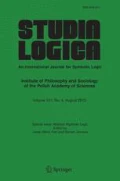Abstract
In their useful logic for a computer network Shramko and Wansing generalize initial values of Belnap’s 4-valued logic to the set 16 to be the power-set of Belnap’s 4. This generalization results in a very specific algebraic structure — the trilattice SIXTEEN 3 with three orderings: information, truth and falsity. In this paper, a slightly different way of generalization is presented. As a base for further generalization a set 3 is chosen, where initial values are a — incoming data is asserted, d — incoming data is denied, and u — incoming data is neither asserted nor denied, that corresponds to the answer “don’t know”. In so doing, the power-set of 3, that is the set 8 is considered. It turns out that there are not three but four orderings naturally defined on the set 8 that form the tetralattice EIGHT 4. Besides three ordering relations mentioned above it is an extra uncertainty ordering. Quite predictably, the logics generated by a–order (truth order) and d–order (falsity order) coincide with first-degree entailment. Finally logic with two kinds of operations (a–connectives and d–connectives) and consequence relation defined via a–ordering is considered. An adequate axiomatization for this logic is proposed.
Similar content being viewed by others
References
Anderson A.R., Belnap N.D.: Entailment: The Logic of Relevance and Necessity, Vol. I. Princeton University Press, Princeton, NJ (1975)
Anderson A.R., Belnap N.D., Dunn J.M.: Entailment: The Logic of Relevance and Necessity, Vol. II. Princeton University Press, Princeton, NJ (1992)
Arieli, O. and Avron, A., ‘Logical bilattices and inconsistent data’, in: Proceedings 9th IEEE Annual Symposium on Logic in Computer Science, IEEE Press, 1994, pp. 468–476.
Arieli O., Avron A.: Reasoning with logical bilattices. Journal of Logic, Language and Information 5, 25–63 (1996)
Avron A.: The structure of interlaced bilattices. Mathematical Structures in Computer Science 6, 287–299 (1996)
Belnap N.D. (1977). A useful four-valued logic. In: Dunn J.M., Epstein G. (eds) Modern Uses of Multiple-Valued Logic. D. Reidel Publishing Company, Dordrecht, pp 8–37
Belnap, N.D., ‘How a computer should think’, in: G. Ryle (ed.), Contemporary Aspects of Philosophy, Oriel Press, 1977, pp. 30–55.
Dunn, J.M., The Algebra of Intensional Logics, Doctoral Dissertation, University of Pittsburgh, Ann Arbor, 1966 (University Microfilms).
Dunn J.M.: ‘An intuitive semantics for first degree relevant implications’ (abstract). Journal of Symbolic Logic 36, 362–363 (1971)
Dunn J.M.: Intuitive semantics for first-degree entailment and coupled trees. Philosophical Studies 29, 149–168 (1976)
Fitting M.: Bilattices and the theory of truth. Journal of Philosophical Logic 18, 225–256 (1989)
Fitting, M., ‘Bilattices in logic programming’, in: G. Epstein (ed.), The Twentieth International Symposium on Multiple-Valued Logic, IEEE Press, 1990, pp. 238–246.
Fitting M.: Bilattices and the semantics of logic programming. Journal of Logic Programming 11, 91–116 (1991)
Fitting, M., ‘Bilattices are nice things’, in V. F. Hendricks, S.A. Pedersen and T. Bolander (eds.), Self-Reference, CSLI Publications, Cambridge University Press, 2004.
Ginsberg, M., ‘Multi-valued logics‘’, in: Proceedings of AAAI-86, Fifth National Conference on Artificial Intellegence, Morgan Kaufman Publishers, 1986, pp. 243– 247.
Shramko Y., Dunn J.M., Takenaka T.: The trilattice of constructive truth values. Journal of Logic and Computation 11, 761–788 (2001)
Shramko Y., Wansing H.: Some useful sixteen-valued logics: How a computer network should think. Journal of Philosophical Logic 34, 121–153 (2005)
Shramko Y., Wansing H.: Hyper-contradictions, generalized truth values and logics of truth and falsehood. Journal of Logic, Language and Information 15, 403–424 (2006)
Wansing, H. and Shramko Y., ‘Harmonious many-valued propositional logics and the logic of computer networks’, in: C. Dégremont, L. Keiff and H. Rückert (eds.), Dialogues, Logics and Other Strange Things. Essays in Honour of Shahid Rahman, College Publications, 2008, pp. 491–516.
Author information
Authors and Affiliations
Corresponding author
Rights and permissions
About this article
Cite this article
Zaitsev, D. A Few More Useful 8-valued Logics for Reasoning with Tetralattice EIGHT 4 . Stud Logica 92, 265–280 (2009). https://doi.org/10.1007/s11225-009-9198-x
Received:
Published:
Issue Date:
DOI: https://doi.org/10.1007/s11225-009-9198-x



